The Roar's A-League Men tips and predictions: Round 26 - the jostle for finals positions is on in earnest
Here is the way the Roar expert panel sees all the action unfolding across the final weekend of play prior to the semi-finals.
Opinion
The longest A-League season will finally come to a close with Sunday’s grand final, where Steve Corica’s first-placed Sydney FC will take on Erick Mombaerts’ second-placed Melbourne City.
Conveniently, it’s a rematch of the game that the two battled out at the beginning of the month. As a refresher, Melbourne City managed to defeat Sydney FC in their previous game, with two mistakes from the Sydney defence gifting City the two goals in a tight game.
Since then, both teams’ form has been mixed. Sydney proceeded to draw games against Adelaide United and Brisbane Roar before losing to Western United, followed by their semi-final win against Perth Glory. Melbourne City drew against Adelaide United, collapsing after a 2-0 lead after Craig Noone got sent off to draw 2-2 in stoppage time, and then winning twice against Western United (one being the semi-final).
I don’t think we’ll see any big surprises in the starting line-ups – both managers have spent their time tuning the line-ups and it seems like their best line-ups played in their respective semi-finals.
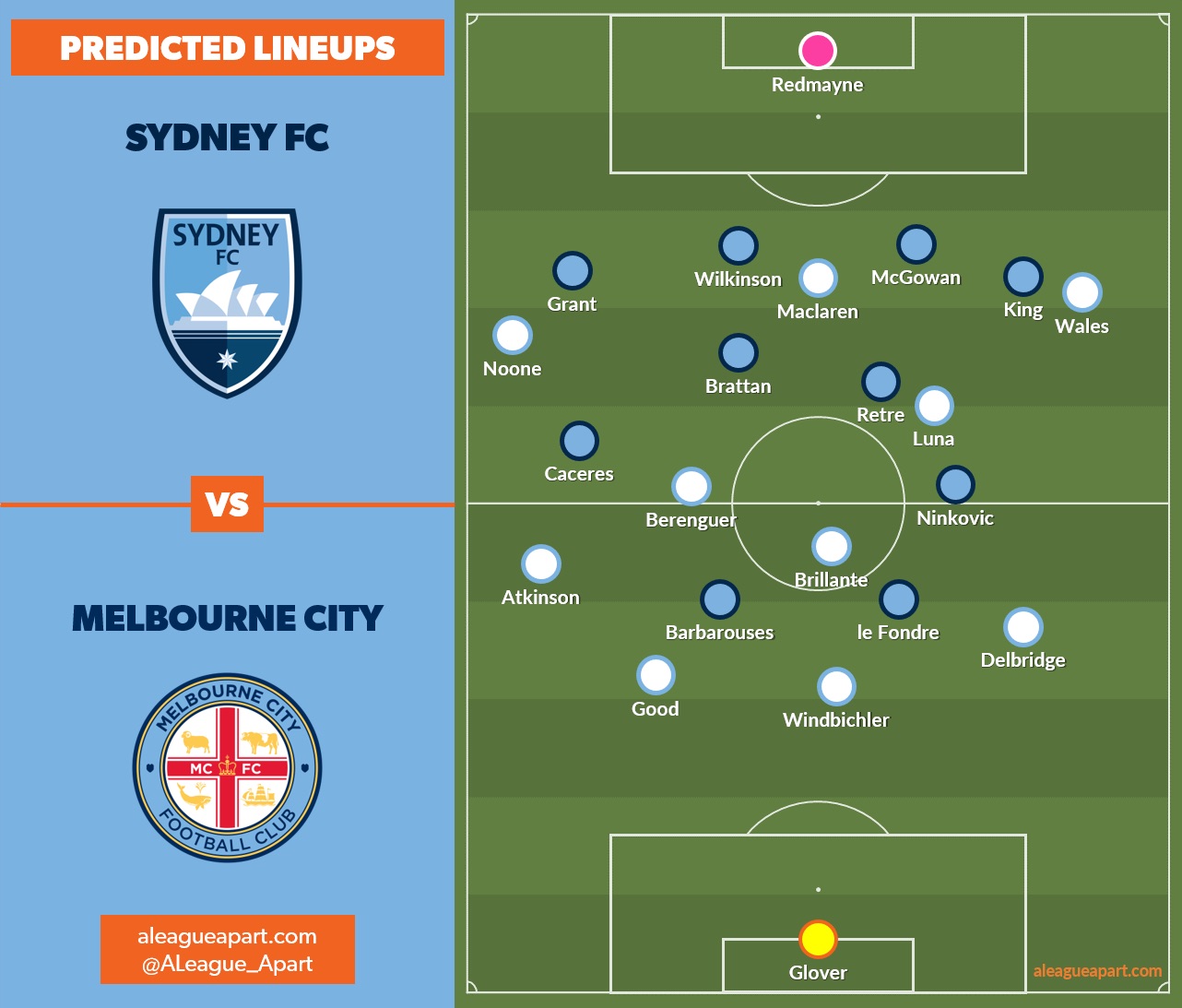
Sydney’s selection notes
Sydney’s line-up should be pretty straightforward. The spine of the team is made up of great partnerships – Adam Le Fondre and Kosta Barabarouses up front, Paulo Retre and Luke Brattan in midfield, and Alex Wilkinson, Ryan McGowan and Andrew Redmayne at the back. Also nailed on would be Milos Ninkovic on the left side of the midfield and Rhyan Grant at right back. The two remaining places are the only other ones with a real likelihood of changing.
Even with Michael Zullo likely returning from injury, left back is likely to be Joel King, who on the balance of this season is likely inching closer to becoming the undisputed first-choice left back. The drawback is that he’s not as technically skilled and composed in the final third, but it seems that Sydney’s players have adapted to this.
The more interesting selection choice is on the right side of midfield. Anthony Caceres definitely put his case forward against Perth, combining very well with Brattan, Grant and Barbarouses on the right, while also industriously tracking back in defence.
Alexander Baumjohann has recently played more of the games at right midfield than Caceres, but this is partly due to players being shuffled around with Grant’s injury. He’s slightly less defensively switched on, but he provides a much more direct option in attack, skipping past defenders to progress the ball forwards and he has a very handy ability to win fouls this way.
Melbourne City’s selection notes
Melbourne City’s line-up should also be pretty straightforward – the line-up used against Western United in the semi-final seems to be their preferred option. Jamie Maclaren will likely start up front with Craig Noone and Lachlan Wales, while the three in midfield seem to be locked in as Florin Berenguer, Adrian Luna and Josh Brillante. Finally at the back, we’re likely to see the (now) standard Nathaniel Atkinson at left back (with Scott Jamieson now at home), Harrison Delbridge at right back, and Curtis Good and Richard Windbichler at centre back in front of Tom Glover.
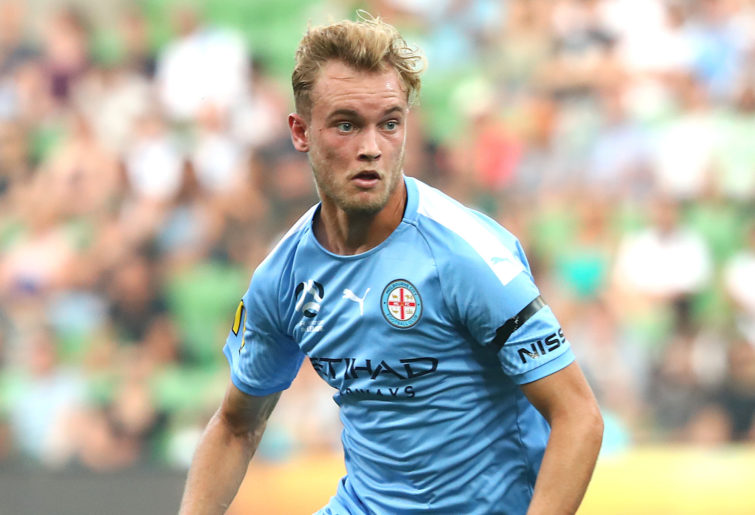
(Photo by Kelly Defina/Getty Images)
The only changes I can see happening are replacing Berenguer with Connor Metcalfe. Berenguer had a very quiet game against Western United, and was unable to really get on the ball effectively. Metcalfe replaced him, and he took up good positions, moved the ball quickly and was a willing and energetic runner in midfield.
Scott Jamieson’s out
Scott Jamieson elected to return home following the birth of his first child, and his absence has meant that Nathaniel Atkinson has filled in at left back instead.
Jamieson’s left back role is an interesting one, as he has the skill set to stay wide and play as a traditional fullback, but also the skill set to come inside into the midfield and play as a central midfielder. In addition to keeping the opponents guessing, it does a few things.
1. It provides more passing options at the back – Brillante and Jamieson in midfield means they have options when building up from the back.
2. Vacating the flank means that the passing lane is left open for balls into Noone or Berenguer when he drifts wide.
3. It creates passing triangles around/in between a 4-4-2 defensive shape.
4. It helps progress the ball, and ping long diagonals into Wales.
Atkinson is a good player, but he doesn’t have the same versatility. Specifically, he’s not as adventurous with his passing, and not as composed in possession. Against Western United, he didn’t have much joy and when he received the ball he wasn’t too adventurous.
He is quite good at defending though, so it’s not like his selection at left back is a bad choice. Besides, he’ll have his hands full…
Rhyan Grant’s in
Rhyan Grant’s return from injury has meant that they have more thrust and attack on the right-hand side than their last encounter. In their previous match-up they struggled, with Paulo Retre (the right back on the day) getting into decent positions, but not confidently able to cross the ball or drive with the ball into dangerous situations when he received the ball on the right.
Grant’s played two games since then and already the right flank looks so much more dangerous, with the pass and move combinations providing a direct attacking option down the right. He combined well with Baumjohann against Western United, and Wednesday’s semi-final against Perth saw him link up well with Caceres.
It was notable how willing he was to provide that direct attacking thrust towards the end of the game against Perth. With Sydney leading 2-0 in the 92nd and 94th minutes the chance opened up twice for a counter and on both occasions Grant immediately started sprinting up out of defence to expose the undermanned Perth defence. He didn’t end up getting the ball on either occasion, but it really highlights the kind of attacking industry that Grant provides from right back.
Sydney’s approach
From Sydney, we’re likely to see an approach similar to how they played in the second half of their previous game against Melbourne City. In the first half of that game, they struggled to deal with City’s press and build-up play effectively, but in the second half they managed to turn it around.
Their structure involved four main points:
1. The central midfielders dropped into the defensive line to help retain possession by providing a passing option when building out from the back.
2. The fullbacks pushed up higher, providing an easy out ball to evade the press. The City fullbacks would have to come out of defence to close them down.
3. The attacking midfielders positioned themselves narrower to open space up for the fullbacks. Their positioning meant that they could be found by their teammates easily once they bypassed the press, and by being in closer proximity to each other, they could combine with each other easier.
4. These movements opened up space for the strikers to use, with the fullbacks being drawn forward.

Sydney always prefer focusing down the right-hand side, with the combination of Brattan, Grant, Baumjohann/Caceres and Barbarouses being a very deadly combination. Here’s an example of a great piece of play down the right from the semi-final versus Perth.
This makes the flank a very interesting battle – Noone will have to track back to help prevent the overload, while Atkinson will need support from both the left centre back and someone from the midfield.
Melbourne City’s approach: midfield
One of the biggest keys for Melbourne City in their build up is the two central midfielders.
In build up, while they start centrally and help to bring the ball out of defence, their primary danger is the movements that they make away from the centre of the pitch into wider positions. When their movements don’t allow them to shift the defence around, they will also start to introduce rotations, alternating as one will drop and the other will push forward, with Brillante offsetting these movements and hoping to free up their teammates. Their movements take them to areas not usually expected from a central midfielder, which often can cause chaos for a defensive marking scheme – especially when it’s more zonally oriented.
These movements also open the door for rotations between positions. As the midfielder drifts wide and the winger comes in side, which player should cover which?
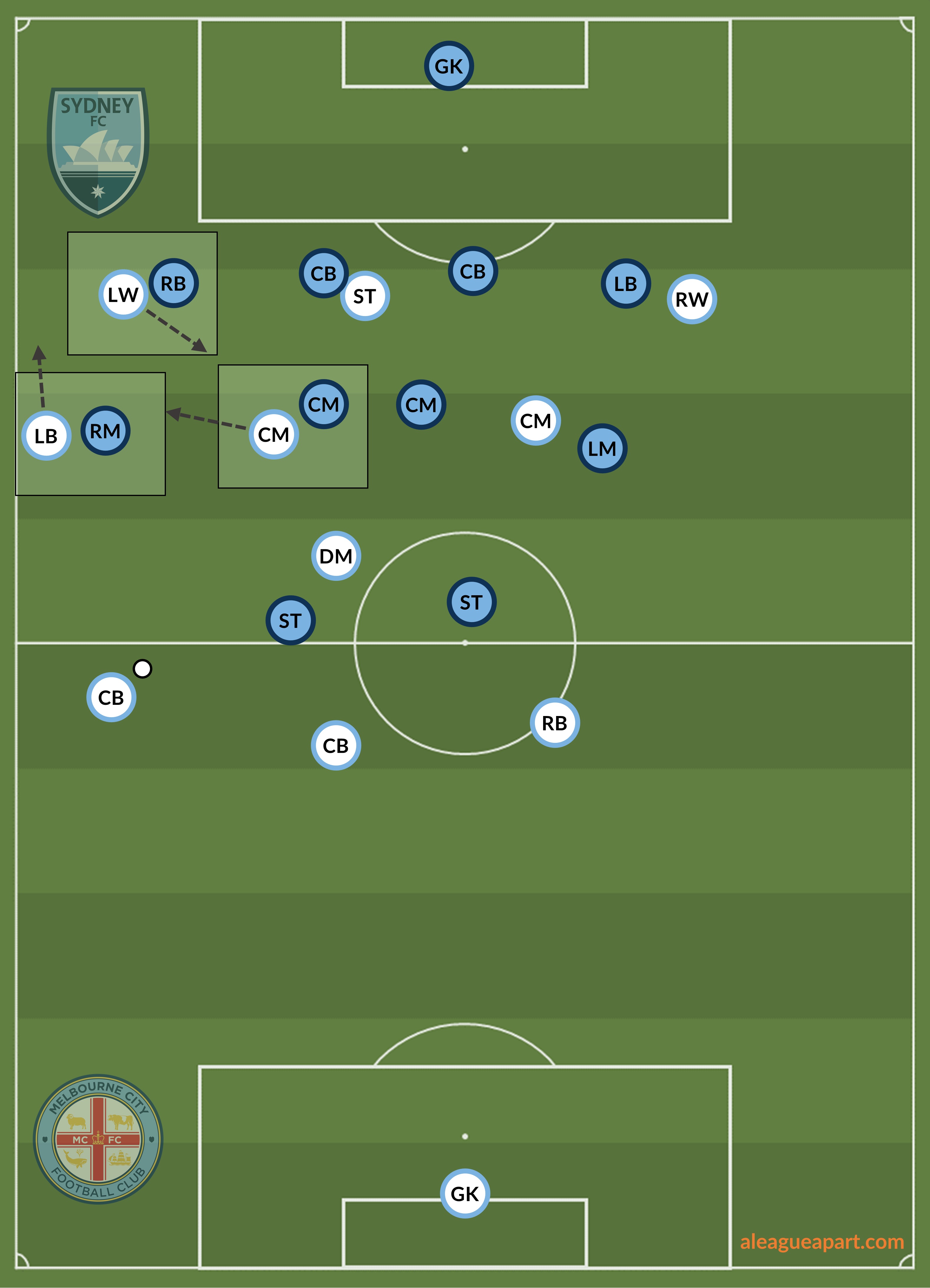
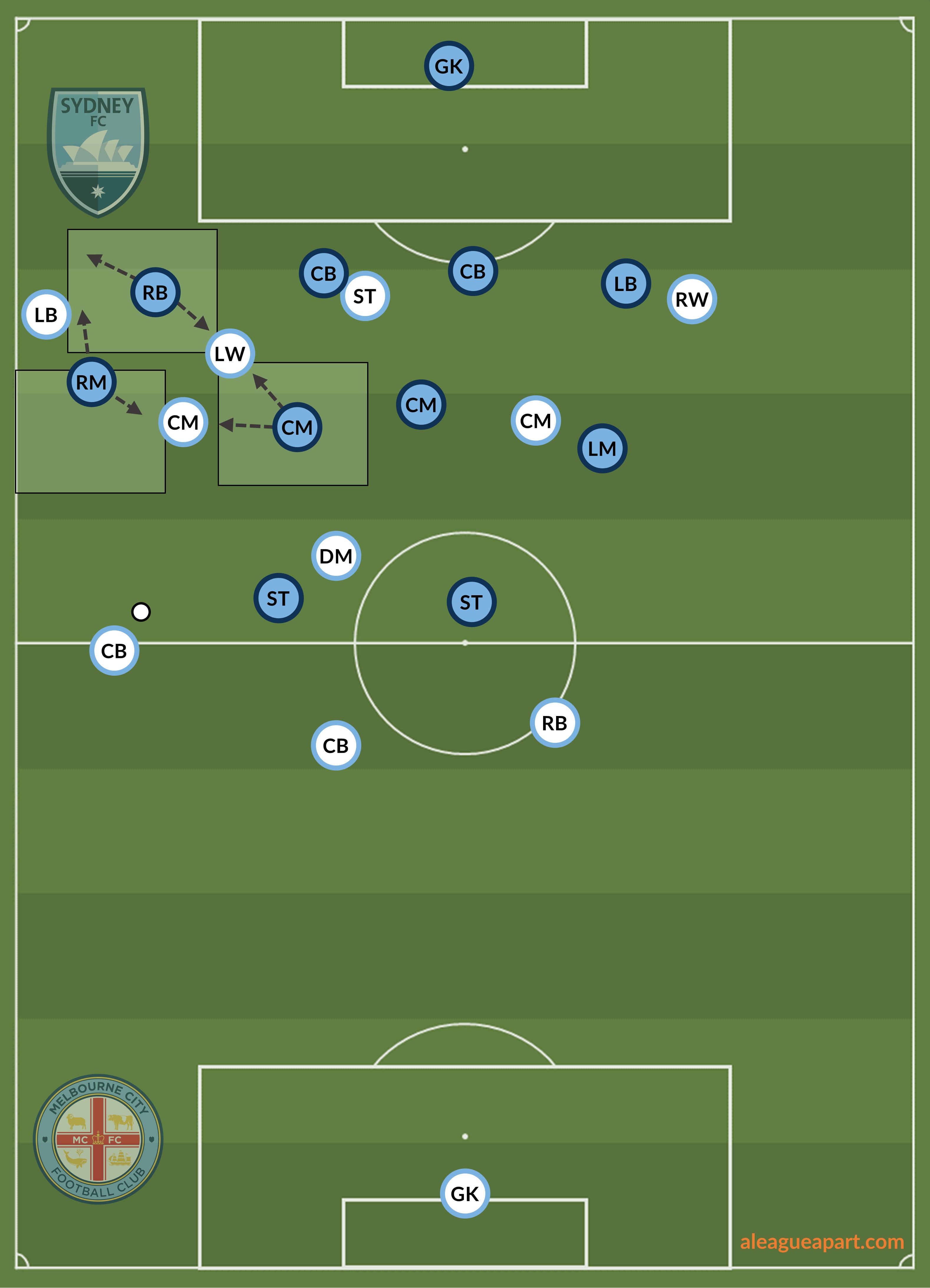
Western United actually coped extremely well with this. They were man-oriented with Luna marked by Sebastian Pasquali and Berenguer marked by Steven Lustica, following them across the pitch when they went wide or forward, but also passing them off well between them when they swapped zones. For example, as Berenguer drops into the six position, rotating with Brillante, Lustica hands Berenguer to Besart Berisha and picks up Brillante. Further forward, Luna pushes forward to counterbalance. Pasquali tracks him and then passes him off to the centre backs when he gets too far forward, and then positions himself in the midfield zone, ready to deal with the second ball.
Because of their tight marshalling of the midfielders, City found it tough to play through the middle for the entire game, and ended up building up using the wide players or playing the ball long. It actually took until the 63rd minute for them to fashion a shot out of a build up that came from the centre, and that was from a situation that both midfielders had pushed up, allowing Brillante to step into a now-vacant midfield.
While this ultimately didn’t work for Western United (they lost 2-0 from goal from a penalty and a corner), it showed what can happen when the midfielders are not given the opportunity to roam freely. I’m not sure if Sydney are particularly equipped to mirror this though – their preference is still to defend with two banks of four behind the front two, which means that there’s ample opportunity for City’s midfielders to find spaces in between the lines through rotations and movements.
The alternative is direct play into Wales, who will be looking to stretch the play wide, and also in behind. He won’t contribute as much to the build up, and instead will always be ready for a switch of play from left to right or a direct ball over the top, and it will be interesting to see his contest against the left back.
While he lacks support from a right back with Delbridge usually sitting further back, support will generally come from the energetic Luna, who loves to get forward centrally and out wide on the right, almost as a supplementary winger. Dealing with these bursts forward will likely form the responsibility of either Ninkovic or Retre – but if it’s the latter, there’s the opportunity for overloads in the centre.
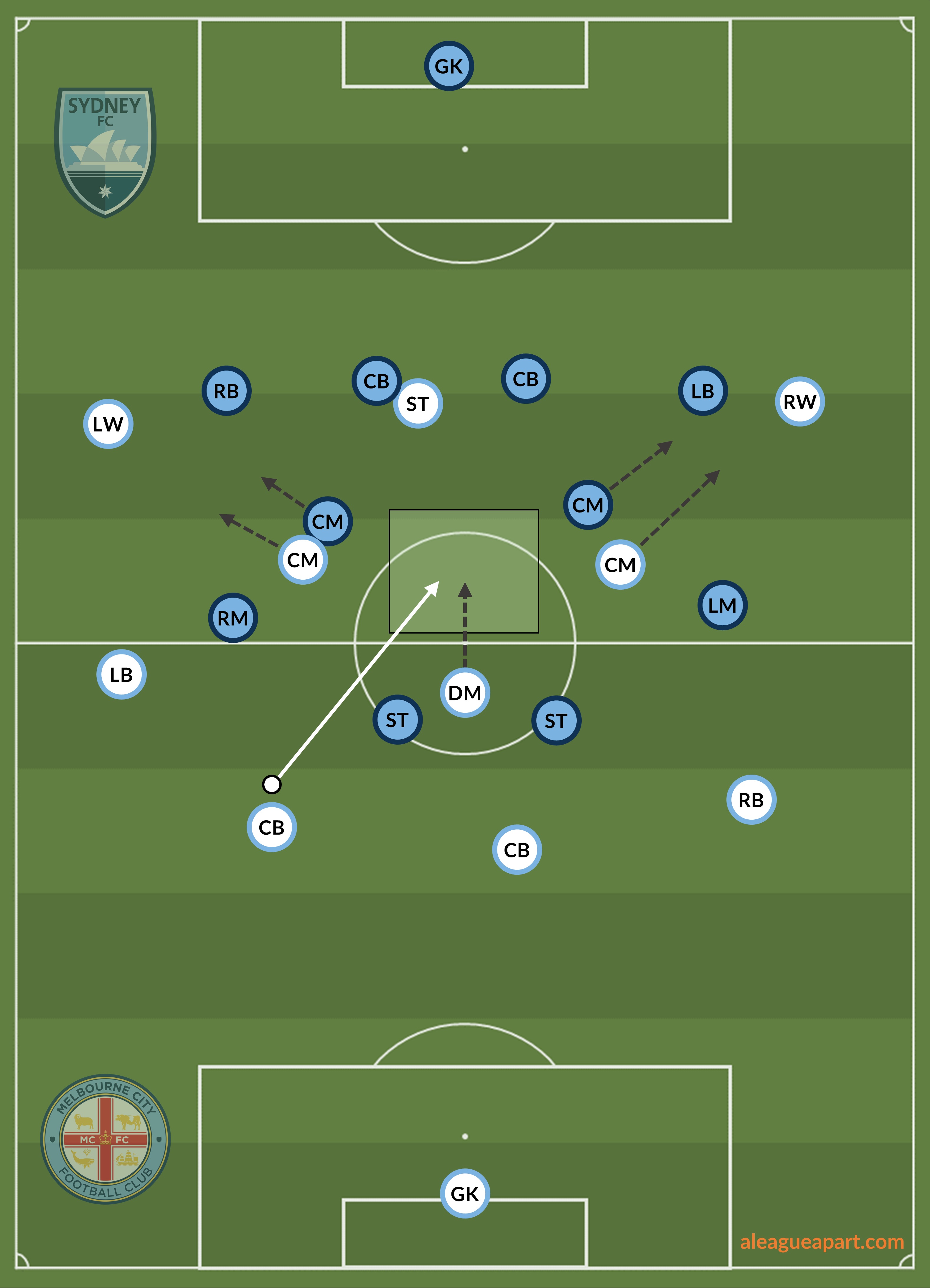
Barbarouses and Le Fondre partnership
I see a lot about how Barbarouses should be dropped (‘Kosta lotta money’ might be my favourite), but a lot of the criticism misses the point. While he may not score as much as people would like, the reason for his continual selection is his ability to play his role in the set up perfectly.
He has a fantastic partnership and great chemistry with Adam Le Fondre. Throughout the pitch their movements are in sync: if one drops deep, the other will push forward; if one attacks the near post, the other will drop off to the penalty spot or hit the far post.
He has technical quality in tight spaces. Countless times Barbarouses and Le Fondre will manage to engineer shooting opportunities from nothing by simply passing the ball between themselves with one-twos.
He runs the channels quite selflessly to help his side progress the ball. His experience playing as a winger comes in handy here and he can get himself free well to combine and cross the ball.
He links play with the midfield well, and he is able to quickly dart into space in between the lines to lay off the ball, helping his team progress the ball forwards.
He presses well. While Le Fondre is usually the one who triggers the press, Barbarouses is always a willing runner whose pace allows him to quickly complement Le Fondre’s press. Taking the goal that Le Fondre scored by pressing Liam Reddy as an example, Barbarouses helps to create the opportunity by sprinting forwards to help Le Fondre. He sees Reddy looking to pass to Osama Malik and quickly cuts out the option forcing him to take a touch instead and allowing Le Fondre to close the gap to score.
He has a good defensive work rate, frequently coming back to help defend central positions. He also has high acceleration, allowing him to stretch the play by threatening runs in behind and into the channels.
It’s also worth noting that he’s got six assists (only one less than a certain Alessandro Diamanti) and seven goals (again one less than Diamanti), while his total expected assists and expected goals lands him at fifth in the A-League.
The alternate options are not as well-rounded as Barbarouses – Trent Buhagiar’s main strength remains his pace on the counter, while Luke Ivanovic is better playing in the midfielder slot as he has technical quality but doesn’t stretch the play as well as Barbarouses.
Summary
We’re poised for another cracker of a grand final, with the season’s two best teams in the league battling it out. Two contrasting styles of play will battle it out, with Sydney’s style of play focused on keeping it tight at the back and then penetrating with rapid, coordinated patterns, while City’s style of play is a more expansive, aggressive and attacking style of play.
Neither side should spring any tactical surprises on Sunday; instead it’ll be whoever can impose their style of play on the opposition more. Can both sides learn from the game they played at the beginning of the month? Both teams have a goal in them, and we’ll see a fantastic game of football on Sunday.